« September 2009 | Main | November 2009 »
October 31, 2009
Black Magic 2

Gou hun jiang tou
Ho Meng-Hua - 1976
Media Blasters Region 1 DVD
I started off October with a review of the first Black Magic movie. The second is not a sequel but another story about non-believers discovering the supernatural. The same cast is involved, but with different roles, but again the action takes place in Malaysia. This time, a doctor and his wife come from Hong Kong to find out why people have some mysterious, incurable ailments, usually involving oversized, throbbing sores, or worms visible beneath what appears to be translucent flesh. Later, the two doctors and their wives go to dinner, where the biggest dish is a featured dancer in a gold bikini. If you're in the mood for a tastefully crafted horror movie, this ain't it.
Black Magic 2 has everything that was great about Black Magic, only more. This means more gratuitous nudity, more gore, and more out and out nuttiness. The only thing Black Magic 2 has less of is anything resembling a logical story or even a dash of common sense. The hero of the film is so dense that it takes until near the end of the film to recognize that the villain is the same person photographed in what is purported to be a study of Asian black magic by "an American professor". One of the characters drives away, and no sooner than our hero steps out on the street, a cab appears, and we hear the immortal words, "Follow that car.".

The magician has an army of zombies, mostly beautiful women, but also a few guys capable of some basic kung fu, because, after all, this is a Shaw Brothers production. The zombies are kept under control with nails in their noggins. We're talking long nails about the size of acupuncture needles. When the nails are pulled out, the zombies go into instant decomposition mode, leaving an oozing mess. The magician also has a passion for milk. Not just your regular cow's milk from the grocery store, or even something more exotic, like organic goat's milk, but milk from youngish woman, from their nipples to his mouth. The unconventional dietary habits don't stop there. At one point, I had to ask myself if I had really just seen one man gulp down another guy's eyeballs.
The only films I can think of offhand that might be more over-the-top than Black Magic 2 might be the early films by Peter Jackson. If there wasn't so much sex and nudity, this film would be ideal for the space traveling wiseacres of "Mystery Science Theater". As it is, Ho packs a lot into an hour and a half, starting with a group of country girls, shedding their wraps for some skinny dipping, only to have one girl eaten by a very large crocodile, who in turn is caught by the good magician who has a dead chicken on a hook over the water. Don't bother seeing this film if you are sensitive to the misuse of dead animals. Whether intended or not, Black Magic 2 is as funny as it is gross. It might not be art, but it is undeniably entertaining.

Posted by Peter Nellhaus at 12:05 AM | Comments (2)
October 29, 2009
Some last minute costume suggestions

Not to be confused with 13 Ghosts, members of the 13 Worms don simple white sheets for their spooky parade.

As dueling sisters in OneChanbara, Eri Otoguro wears a studded bikini, knee high boots and a cowboy hat, while Chise Nakamura chooses the popular school girl uniform with thigh high black stockings. Samurai swords are optional.

And if any guys are in doubt about how to celebrate Halloween, as Bat without Wings proves, the Gene Simmons look never is out of style.
Posted by Peter Nellhaus at 12:46 AM | Comments (1)
October 28, 2009
Asian Streams

Haze
I intermittently watch movies that are streamed on my computer. I don't do it often, and I restrict myself to films with shorter running times, in the range of ninety minutes. Most of what I have seen has been through Netflix, either as a means of weeding out a film or two to allow room for other DVDs, or to see some films that would not be available otherwise. I was intrigued when Wise Kwai had a posting on his website about Asia Pacific Films. I have added a link to that site on the right. This is a website that specializes in streaming films from Asia. India and Iran are included with China, Thailand, Singapore, Hong Kong and other countries, as well as including some films from filmmakers who are part of the Asian diaspora.
I have, at the time of this writing, seen two of the short films by two relatively well known filmmakers. Haze is part of Shinya Tsukamoto's exploration into the horror of the physical body. A man wakes in a cramped space, uncertain of where he is or how he got there. Unable to get on his feet, he can only move side to side on his back. The man passes out, and awakens in another physically compromised position, having his mouth forced open by a length of pipe. It is unknown whether the man is actually finding a means of escape or is simply getting himself deeper into a trap from which he cannot escape.

Influenza
Bong Joon-ho's Influenze is purported to be edited from the closed circuit videos of a "Mr. Cho", and his criminal career over a span of three years. The video tapes were shot on the streets of Seoul, a men's restroom, a convenience store, and a couple of banks. The half hour film is as dark and funny as Bong's features, especially a scene where the would be bank robber is surprised to find himself feted by the bank he is about to rob, along with being photographed by the bank management.
Neither of the films I saw had English subtitles, but there was enough visual story telling to convey the filmmakers' intentions and idea. I found out later, from the very responsive team in charge of Asian Pacific Films, films are to shown with English subtitles. As I saw the two shorts as part of a promotional period ending this week that allows for free viewing, I have to assume that this time is used to verify that the website is working as intended, and to iron out any reported glitches. There are several films that have English as the primary language. In any case, Asia Pacific Films is welcomed as a means of seeing films that may not even play at film festivals, not to mention the most dedicated art house.
Posted by Peter Nellhaus at 09:20 AM
October 26, 2009
I Aim for the Starz
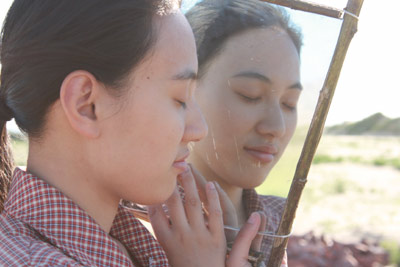
Fish Eyes
In Thailand, there's a saying, "Same same, but different". The schedule for the 32nd Starz Denver Film Festival has been officially posted. And the Thai expression seems to be applicable here, at least for me. The mix of films seems pretty much the same as in past years. I knew there would be more Mexican films, a move to attract Denver's significant Chicano population. I was not expecting as many Iranian films to be included. The number of Asian films has not increased, which disappoints me with the absence of the Asian Film Festival that brought in about eight films, some which would not get theatrical release. I am trying to be a little sympathetic towards the Denver Film Society.
With a combination of a financial shortfall, a change of leadership that came in June, certainly with its own financial price, the Denver Film Society has even more reason to be conservative in some of its choices, certainly with the major attractions, such as Precious as the opening film. What seems to be a major challenge is getting people who flock to the film festival and general keep the smallish auditorium filled, or nearly filled, to come the rest of the year. I was the only one in the audience when Tony Manero and Nollywood Babylon had their weeklong runs. It seems like it's only when the film is included as part of the festival that viewers are more willing to take a chance.
Of some interest this year will be three documentaries related to the 2008 Democratic convention. One, titled Convention is by A. J. Schnack, a festival regular, and co-produced by Britta Erickson, the festival director. Hick Town is about Denver's generally well regarded Mayor John Hicklenlooper, with filmmaker George Hickenlooper taking advantage of family relationships. George Hickenlooper's film about an unofficial mayor, Rodney Bingenheimer, The Mayor of Sunset Strip was an interesting look at Los Angeles and pop culture. Barry Levinson has a bi=partisan look with his documentary, PoliWood.
Of the few Asian films to be featured, I am looking forward to Fish Eyes from China. Full admission here, I've been an internet pal with Benten Films cofounder Andrew Grant from about the time I launched my site here, so I am excited that his recently acquired feature will be seen theatrically. My Dear Enemy will be my introduction to Lee Yoon-ki. I've read good things about Lee's previous film, Ad Lib Night. I am disappointed that programmer Brit Withey still could not get his hands on The Good, the Bad, and the Weird. There is also the Taiwanese film, Yang yang by Cheng Yu-chieh. Clearly, I am going to have to continue seeking Asian films of interest though Netflix, assuming there's a U.S. DVD release, or with my own bulging collection of imports.
Anyone with thoughts about films I should make a point of covering, please let me know in the comments. I've had my flu shot, so I should be healthier than I was during last year's festival. I will try to cover a reasonable number of films, partially based on what advance screenings I can attend, films and events I want to see in person, and screeners that are available to me.
Posted by Peter Nellhaus at 06:33 AM | Comments (4)
October 25, 2009
Coffee Break

James Westmoreland and Rick Cooper in The Undertaker and his Pals (T.L.P. Swicegood - 1966)
Posted by Peter Nellhaus at 12:08 AM
October 22, 2009
Vengeance

Phairii phinaat paa mawrana
Preaw Sirisuwan - 2006
BCI Region 1 DVD
Vengeance is a handsomely produced bit of nonsense where the CGI creatures prove more charming than the actual people. There is some genre blending where the story about a group of cops in pursuit of some escaped criminals evolves into horror and fantasy, the deeper the characters run into the jungle, the film likewise becomes less realistic. Preaw, who both wrote and directed the film, has a narrative that relative to its genre almost makes sense, but seems especially enamored of envisioning all manner of fanged terror.
In its own bizarre way, Vengeance is about filial piety. The main criminal, Naso, is introduced as a young boy who escapes from the same jungle with his father, only to have his father die under mysterious circumstances. The main cop, Wut, is the son of a criminal from the same gang, who saw his father arrested. One of the pivotal characters is a Buddhist monk, addressed with the honorific title of "Father", who is in fact the father of Wut. The cop who arrested Wut's father has become Wut's father figure. There is also an older man who acts as the jungle guide, accompanied by his granddaughter, and a matriarchal head of a jungle clan. The main narrative opens with the capture of a member of Naso's gang, who has returned home, missing his wife and daughter. Naso's father has stolen a stone medallion that belongs to the jungle tribe, a device used to connect all of the characters at the film's conclusion.
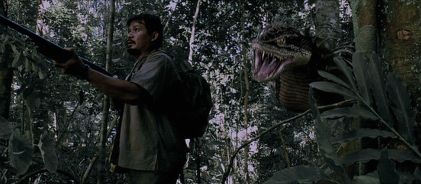
But the best part of the film? I love those half alligator-half gecko creatures that climb rapidly down the green trees and leap upon their helpless victims, mouths open wide with hungry grins, ready to dine on human flesh. There is also a weird beauty to the vampire like creatures who spread their wings that resemble veiny leaves. The devil anaconda is mostly from the bigger is better school of fantasy creatures. The fruit tree maidens are a couple of attractive young women, seen bathing nude by moonlight, their long hair strategically placed over their breasts, allowing one foolish man the opportunity to come to a literal understanding of "la petite mort". The first scene of horror is of the tiger wasps, thousands of CGI creatures who make like tiny, flying piranas. Even the sky is ominous, with dark clouds swirling counter-clockwise. Preaw keeps upping the ante so that it's more interesting to see what kind of creatures will next appear to create mayhem, with any concern about the characters escaping the jungle evaporating at each sighting of a set of long, sharp teeth.
While the brief "Making of" documentary does not mention where Vengeance was shot, Preaw should get credit for making the film on location. The film takes place in a jungle area in northern Thailand, near the Burmese border. There is mention of Preaw's background in filming commercials in the documentary which might explain why the film seems more visually polished, with greater attention to the framing of the characters. The title more literally translates as "Evil Spirit of Revenge", and while it is easy to identify the evil spirits, it is less clear who is having their revenge. Curiously, the American DVD version is the true theatrical version, while the Thai DVD version has reportedly been censored for "family" audience watching at home. True to its mission of keeping young adults from watching movies with subtitles, Vengeance was pointlessly rated "R" by the MPAA even though it is less graphic than several Hollywood films anointed PG-13. Preaw almost tips over to the wrong side of pretentiousness on more than one occasion. Fortunately, a fervid imagination resulting in toothy, hungry demons makes Vengeance a twisty pleasure.

Posted by Peter Nellhaus at 12:01 AM
October 20, 2009
Black Rain

Kuroi Ame
Shohei Imamura - 1989
AnimEigo Region 1 DVD
In discussing the challenges of translating Masuji Ibuse's novel from Japanese to English, John Bester writes, " . . . the author invariably balances the horrors he describes with the wry humor for which he has long been famous." Those words can also be applied to Shohei Imamura although the filmmaker's own wry humor is more subdued here, in what is probably the most serious, and saddest of his films. Black Rain is at times a very difficult film to watch as well as write about because of its subject matter which can not, nor should not be trivialized. It is also daunting to encourage anyone who has not seen Black Rain to view the DVD without it seeming like there is the force feeding of spinach, "because it's good for you". Bester also discusses how some critics complained that Ibuse "played down" the horrors of the bombing of Hiroshima and its aftermath. Some of Imamura's images are extremely disturbing, rightly so, without being exploitive, and yet I get the feeling that what I saw was less horrifying than what happened in real life.
Most of the film follows three survivors, a young woman, Yasuko, and her aunt and uncle, Shigeko and Shigematsu. The main narrative takes place in 1950 when the effects of radiation, even on those who had little immediate injury, we still being understood. The aunt and uncle are struggling to get Yasuko married, in spite of rumors regarding her health. The three live in a small, rural community, where in spite of the distance, everyone's lives are affected by World War II as well as the ongoing war in Korea. Ibuse's novel and Imamura's film are not simply about the destruction of a Japanese city, or the physical and psychological effects of the bombing, but how Japanese society underwent changes. Similar to what had happened in Great Britain after World War II, was a shift in Japanese class consciousness in Japan. Shigematsu and Shigeko hold on to their last vestiges of their aristocratic history. The one man that Yasuko almost marries, Yuichi, is a veteran suffering from what we now call Post Traumatic Stress Disorder. Yuichi's mother apologizes for broaching the subject of marriage due to class difference. For Yasuko and Yuichi, it is two injured souls finding temporary solace with each other. Black Rain is about people seeking their own sense of place in an environment that is indifferent, if not hostile.
Even for those who have seen Black Rain in its original theatrical version should see the DVD because of one very significant extra. Imamura had written and filmed an ending, in color, different from the one in the novel. After second thoughts, that ending was scrapped in favor of ending the film as Ibuse had written. Imamura's ending follow Yasuko through 1967, divesting herself of all material comfort, becoming a mendicant, perpetually on pilgrimage from shrine to shrine. The scene is Imamura criticism about how survivors of radiation poison are often avoided because of their existence as reminders of the bombing. That Hiroshima was virtually destroyed by a bomb that has only a fraction of the destructiveness of current weapons has become a very abstract idea, underlined by Imamura with a shot of people selling what are claimed to be rooftop tiles from the bombing in front of the building that has served as a memorial, followed by a shot showing the memorial building as virtually lost amidst the modern, flourishing Hiroshima. Rather than being judgmental on which ending should have been used, the inclusion of the unused ending points to a discussion on the degree to which a filmmaker honors the literary author's original vision or asserts his own ideas.

The DVD also provides some insight into Imamura's working methods with interviews conducted by Imamura's son, the screenwriter Daisuke Tengan. Takashi Miike served as a Second Assistant Director on Black Rain, often running afoul of Imamura's darker moods during the course of making the film. Previously working on the film Zengen, working under Imamura also served as the springboard for Miike and Tengan's own collaborations, most famously with Audition. There is a brief interview with Yoshiko Tanaka who won several awards for her portrayal of Yasuko. In spite of the honors, it seems incomprehensible that Tanaka followed up her performance with roles in two "Godzilla" movies. There are also documentaries from World War II which illustrate the extent to which the Japanese people were demonized for an American audience, as well as further DVD notes that explain further some of the references used by characters in the movie.
Shohei Imamura's filmography has been inconsistently served on English subtitled DVDs. This past year has seen the recent release of three Sixties films available from Criterion, with Black Rain as the fourth title made available this current year. Between the readable colored subtitles, as well as occasional explanatory titles, plus the extras mentioned above, Imamura has been well served by AnimEigo. The first twelve minutes are graphic enough that I saw people leave the theater when I first saw Black Rain in 1989. At a time when various, sometimes risible ideas of horror exist as entertainment, an enactment of history serves as a reminder of horror of worst kind.

Posted by Peter Nellhaus at 12:30 AM | Comments (2)
October 18, 2009
Coffee Break

Al Cliver in Devil Hunter (Jesus Franco - 1980)
Posted by Peter Nellhaus at 12:05 AM
October 15, 2009
Sigaw
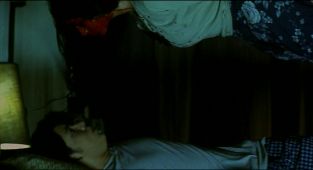
Yam Laranas - 2004
Regal Entertainment Region 1 DVD
Yam Laranas bears the distinction of not only being the first Filipino filmmaker to have his film remade in a bigger budget English version, but to do the remake himself. That version, titled The Echo, has ended up going straight to DVD in the U.S., although it has enjoyed theatrical distribution elsewhere. Comparisons between the two version will be made by others in November while I'll be devoting my time to the Denver International Film Festival. For those who would rather not wait, or are simply in the mood for a horror film more interested in general creepiness rather than gore, Sigaw is a modestly effective film.
With apologies to James Whale, but this current century seems to see the creation of a sub-genre that might be called "the old, dark apartment". Basically it involves a character who moves into a decrepit apartment building most people would just as soon move out of. The apartment almost always features a big, ugly stain on the ceiling, faulty fixtures, and just enough noise to keep most people from sleeping at night. There may or may not be any other neighbors that one meets, but there seems to be someone or something that appears out of nowhere with the goal of make life more nerve wracking. There's almost always a mystery child. The ghosts that hang around the building do so because of some unresolved issue that causes them to repeat the actions that lead to their death. The ghosts are usually only seen by the person who had the misfortune of moving into the wrong apartment where tragedy took place years before.
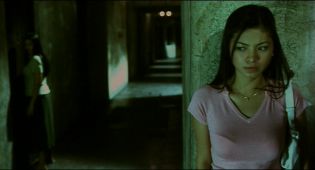
Then again, maybe the story is besides the point, and that there is a sense of comfort for a genre film to follow a familiar arc. This might be comparable to a classic western that we watch anyways, always with the knowledge that Randolph Scott-John Wayne-Robert Mitchum will save the day, or at least make things more right than before he showed up. Yam Laranas basically took a familiar story, but what make Sigaw of interest is how he made use of some relatively spartan resources.
A young man who works at a restaurant, Marvin, has taken his entire small inheritance and bought an apartment in the ugliest building in Manila. His girlfriend, Pinky, tries to talk Marvin into moving out to a nicer place. Meanwhile, Marvin is kept awake at night by the neighbors, an angry cop who is convinced his wife is cheating on him and that he is not the father of their daughter. Things get more troublesome when the neighbors start appearing in Marvin's dreams.
This first version has a relatively small cast primarily using six actors. Laranas did the cinematography himself, with much of the action taking place deliberately in a sickly blue-green light. I've seen alleys better lit than the interior of the apartment. One of the most visually striking scenes is of the tightly wound spiral staircase, looking almost like the inside of a seashell. The film is one of several that paired Richard Gutierrez with Angel Locsin. While acting in Filipino films leans towards the melodramatic, Laranas is able to tone it down to a more realistic level. Without giving away spoilers, Locsin impressed me during the last third of the film in a very physically demanding scene when she thinks she is alone in an empty apartment. Laranas makes creative use of sound near the end of the film, which explains the echo referred to by the title.
For those interested, here is an interview with Yam Laranas.
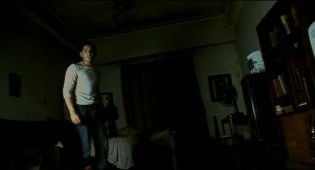
Posted by Peter Nellhaus at 12:14 AM
October 13, 2009
Curse of February 29th

2 wol 29 il
Jong Jung-hun - 2006
Pathfinder Home Entertainment Region 1 DVD
Curse of February 29th is a modestly produced horror film that is effectively creepy in spite of the fact that a major plot twist is virtually given away in the opening scenes. The premise, of a serial killer returning from the dead every four years is something I'm surprised no other filmmaker has jumped on before with the Friday the 13th series, as well as various holiday based horror films. To the best of my knowledge, this is the only film by Jong Jung-hon, and it looks like he spent time studying such films as Psycho, Repulsion, and the first Nightmare on Elm Street, not so much mimicking the films in style as much creating a constant sense of unease with his female protagonist drifting in and out of her own shifting reality.
Ji-yeon is a young woman who works at night at a lonely tollbooth. During a blackout, a car stops, and she's handed a ticket smeared with blood from a woman unseen, except for her manicured hand. Ji-yeon is convinced that a woman, a convicted serial killer, has returned to claim more victims. The woman seems to have disappeared during a fire that claimed everyone else traveling in a van, the previous February 29th, at another tollbooth. The mystery woman is now going after other tollbooth employees and is trying to kill Ji-yeon. More strange is that the scarred face killer dresses exactly like Ji-yeon, appearing almost as a twin to the frightened young woman.

How much is intended, I can't be certain of, but there seems to be something of a feminist message in the film. Ji-yeon lives a very isolated existence. Her only friend is another young woman, Jong-sook, who also works at the tollbooth. Ji-yeon is also, while not unattractive, not particularly pretty, and comments to Jong-sook about how she considers her face common. None of the men that Ji-yeon encounters take her seriously, whether it's the unseen boss, the journalist who doodles on his notepad while Ji-yeon recounts her story, her doctor who provokes Ji-yeon's anxiety about February 29th, or the police detectives investigating who are suppose to protect her. Even perceived sources of protection such as bright lights in her apartment, or a crucifix ultimately tossed away, fail Ji-yeon.
There is an effective use of music and sound, with some discordant string plucking and even the shrieking violins that suggest Bernard Herrmann's Hitchcock scores without obvious imitation. Jong has some interesting use of color, particularly a tunnel bathed in red light, and a lighting store that is dominated by a golden hue. The film was written by Yoo Il-han who also two other films that were part of a four film series, "Suddenly One Day". The four films were produced for about $600, 000 and shot in HD format, initially with brief theatrical runs followed by television broadcast using newer directors and a cast of relative unknowns. The two other films written by Yoo have U.S. DVD titles of The Hidden Floor and My Blood Roomates with reviews at the valuable website Korean Film. If past history is any indication, Jong Jung-hun could be a stylist worth watching out for, or we may have at worst, a future Hollywood remake by lazy filmmakers for a lazier audience.

Posted by Peter Nellhaus at 12:18 AM
October 11, 2009
Coffee Break

Judy Matheson and Andrea Allen in Scream . . . and Die! (Jose Larraz - 1974)
Posted by Peter Nellhaus at 12:24 AM
October 08, 2009
Coming Soon

Sopon Sukdapisit - 2008
Sarawak Media All Region DVD
There is a scene in Coming Soon that takes place in a room with the lights off, with the screen black. It's the kind of scene that you know is much more effective in a movie theater rather than viewed at home on DVD. Much of Coming Soon takes place in a Bangkok multiplex, similar to the one where I saw Alone, my last Thai movie seen in Thailand. One of the writers of Alone, Sopon Sukdapisit, made his directorial debut with Coming Soon, a horror movie about a horror movie. Based on my own experience watching ghost stories in Thai theaters, I could imagine what seeing Coming Soon might have been like at the Major Cineplex in Chiang Mai.
The film begins with a private screening of the horror film within the film, The Revengeful Spirit, a title that pretty much applies to every Thai ghost story made. The gruesome story about a mad old woman who kidnaps and blinds children she claims as her own, the woman, Chaba, is discovered and hanged by some very angry parents. During the running of The Revengeful Spirit the director has walked out. His girlfriend finds him, and he mentions editing the scene of the hanging. It is later that his reasons are revealed.

In the main narrative, a movie projectionist, Shane, has arranged to run The Revengeful Spirit again with coworker, Yod, in order to make a video pirate copy to be distributed prior to the films release date. Shane has some money trouble from a drug habit, and the pawning of the watch belonging to his girlfriend, Som. A couple of young thugs are the least of Shane's problems when he discovers his life repeats scenes in The Revengeful Spirit, and the ghost of Chaba visits him at home as well as the theater. Shane and Som discover that The Revengeful Spirit is indeed based on a true story, but the horror that they experience comes from the making of the film. Life and cinema merge for Shane. I don't know if Sopon Sukdapisit is familiar with Woody Allen, but one might call Coming Soon the Purple Rose of Cairo of Thai horror movies.
As far as Thai horror films go, Coming Soon is nowhere as good as Alone, or even Shutter or the funny and scary episode, Last Fright in 4bia. The characters in the films Sopon helped write, but did not direct, are more fully imagined. The most interesting character in Coming Soon is Chaba, both the woman seen in The Revengeful Spirit and the real life version that Shane and Som encounter. There is also a plot point that makes no sense, where the supposedly missing movie is never found in the most obvious place to look first. As in too many horror films, gore is equated with horror, with one of the images a direct lift from the Thai horror hit, Sick Nurses. Some of the credit, or blame, might go to co-writer Kongkiat Khomsiri. The scenes of The Revengeful Spirit have more in common with Kongkiat's two Art of the Devil entries than with Sopon's films with the Shutter team. There is one amusing scene where Shane finds himself repeating his actions, as if in an endless loop. One of the other effective scenes is of Shane's search for Yod's cell phone, heard, but not seen. Unlike many Thai horror films that aim for laughs as well as screams, Coming Soon goes for the jugular as soon as it begins. Coming Soon might have been a much better film had Sopon not relaxed his grip.

Coming Soon is available from HK Flix.
Posted by Peter Nellhaus at 12:06 AM
October 06, 2009
Tiyanaks

Mark Reyes - 2002
Regal Entertainment Region 1 DVD
There is a universality to Tiyanaks as a PG-13 style horror movie about dumb kids who do dumb things. This is the kind of film where it is almost a given that provided with just enough clues, the audience would rather not tread in the places where these fools rush in. But what makes the film almost worth a look is that this is a very culturally specific kind of horror movie.
As a Filipino horror movie, one might carp about the quality of the acting and the special effects. One might also complain that there's nothing particularly scary or even suspenseful. What is of interest is that the monsters are from Filipino mythology. Also, the film is steeped in Catholic belief that is different than what is shown in most western films. The action takes place during the weekend before Easter, with a group of college students off to a remote house for the holiday. Right before leaving, most of them have attended the class of Professor Earl, who is teaching a class on Filipino folk beliefs. The kids are taken by van, driven by a man who forgets which way to turn at the fork in the road. Of course he takes the wrong way, and the kids eventually find themselves at a mansion in the middle of a forest, home of a woman and her young boy. The woman reluctantly allows the kids to spend the night at her house. The kids, of course, leave the house at night in spite of the warning to stay inside, looking for food who knows where, after being told that they are about three hours away from the closest city.
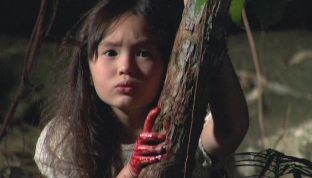
One of the recurring lines stated by the mother is that, because it is Holy Week, "God is dead". As the subtitles seem to be reasonably well translated, I have to assume that this is a reflection of Filipino Catholic belief that is idiosyncratic to that country. While driving to the retreat, two men are seen, one with a thorn cross, both engaged in self flagellation. The tyanaks are fought off with the rubbing of a small personal cross, a knife hidden inside a wooden cross, the splashing of holy water and even a prayer of baptism when one of the little monsters is trying to drown one of the young women. The tiyanaks, at least the ones in this film, seem to reflect lingering beliefs in animism, both in their linking with the elements of fire, water and air, but in their shape shifting ability that helps them blend into their forest environment. Scariest of all is that the tiyanaks have more personality than their human victims.
Tiyanaks was reportedly a big hit for Filipino audiences. I'm not sure if the big draw was a more contemporary take on an old myth, or the popularity of some of the stars, especially Rica Paralejo. There may not be much of a compelling reason to bother with a film like Tiyanaks other than that it can serve as proof Asian horror films are in no way generic, and that a film made primarily for commercial gain can reveal much to the audience about the culture of its origin.

Posted by Peter Nellhaus at 12:37 AM | Comments (1)
October 04, 2009
Coffee Break
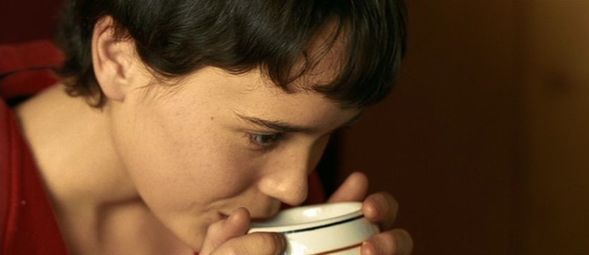
Ellen Page in Hard Candy (David Slade - 2005)
Posted by Peter Nellhaus at 12:19 AM
October 01, 2009
Black Magic

Jiang tou
Ho Meng-Hua - 1975
Image Entertainment Region 1 DVD
Black Magic is one of the few examples of the Shaw Brothers forays into horror. What may open a few eyes is actually the erotic content, with a fairly generous amount of nudity. What makes the film of interest are the various elements that one does not usually associate with the film company primarily known for its martial arts movies.
The black magic is seems to be similar to voodoo, with effigies, chickens, potions designed to make people fall in love, desecrated graves, and unintelligible chants. We are introduced to Master Shan who is hired by the spurned wife to create a death spell on her adulterous husband and his young mistress. Shan does his work with two dolls sized effigies, a female and one well endowed male, and a handful of long, sharp needles. A rival magician casts a spell that almost spells doom for Shan who disappears into a river.

Xu and Quming are a young couple in love. Xu's boss, the attractive young widow, Luo Yin, is in love with Xu. Sleazebag Liang is in love with Luo Yin. Luo Yin is so rich that she lives in a large mansion and drives an expensive sports car. What her money can't buy is Xu, or clothes that don't reveal visible panty lines. Liang hires Shan to cast a spell on Luo Yin, which works, but just for one night. Luo Yin pays Liang to introduce her to Shan, so he can cast a spell on Xu. Shan promises a spell that will work for one year as long as Luo Yin comes up with the money. As shown in an earlier scene, one of the fringe benefits of being a magician is to order attractive female clients to get naked, so it's no surprise that Shan has interests in Luo Yin that extend beyond the professional.
The cast is made up of Shaw Brothers contract players such as Ti Lung, Lily Li and Lo Lieh. This is the first film I've seen directed by Ho Meng-hua. Aside from the film being a shift in genres, what was unexpected was the use of electronically generated sounds as part of the soundtrack. The special effects used some of the same kind of time lapse photography used in old Universal horror movies, with faces melting into dust, and some colored bolts that rival magicians use against each other that looked cheaper than anything seen in a lesser science fiction film from Toho Studios. It should also be noted that while the film was made with Hong Kong talent, the shooting location was Malaysia. Part of it may have been to take advantage of a more wild environment than available in Hong Kong, but I suspect the filmmakers would consider contemporary Hong Kong too sophisticated a place to have practitioners of magic or those who believe in their spells. Most of the magic on screen belongs to Ku Feng as the evil magician. Whether threatening a potential victim, or leering at a female he hopes to seduce, it's never a subtle performance, but, like a good movie villains, Ku is the most fun to watch. Not only does Ku ham it up with his skull and sorcery, but he gets two racy scenes, one with the gorgeous Tien Ni. In the other scene, Ku cooks up one of his potions using a unique recipe to create a very unique version of that Asian staple, sticky rice.

Posted by Peter Nellhaus at 12:17 AM
